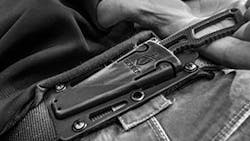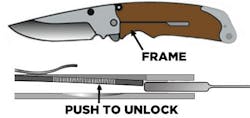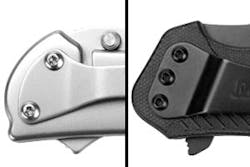Industry Insight: Choosing the Best Duty Knife
By David Workman, Propper International
One of the most important tools on your duty belt isn’t your gun. That’s important, but you use itsparingly, maybe even once in a lifetime or not at all. But one critical tool that you not only carry with you on duty but also off duty is a good tactical knife. There are a ton of great brands and options out there. How do you choose?
Whether for self-defense or just to keep handy for mundane tasks, a good knife not only gives you peace of mind for those times when you might need to ward off a threat but also for those everyday functions like cutting through ropes, strings, and box tape. But what knife is best? It depends on what you want and need.
Fixed vs. Folding
The first consideration is a fixed or folding blade. This decision depends almost entirely on how you intend to carry it. A folding knife does exactly as it says: folds up into itself to safely cover the blade for easy carry. A fixed blade does not fold up, remaining exposed until covered with a leather, nylon, or hard-cover sheath. Folding knives can usually fit easily into a pocket for concealment vs. a fixed knife that usually attaches to a belt or bag and is often visible from the outside. If you need your knife in an instant without consideration of concealment, the external-mounted fixed blade is a great option. If you need to be more low-key, the concealed folding knife works better. It’s all about the application.
Locking Mechanism
Some knife aficionados will tell you a folding knife is not stable enough for the rigors of certain applications. In the old days before locking blades, that certainly held true. All it took was a slight miscue and the blade slapped closed – and your fingers got a knuckle shorter. Nowadays, however, locking mechanisms are so advanced and reliable that this is barely an issue anymore. The biggest issue with locking mechanisms is which one is easier to operate. While there are many different devices invented over the years, the two most common locking mechanisms on knives today are the Lockback and Liner Lock.
Lockback
Liner Lock
Clip Style
A concealed folding knife can be either carried inside the pocket or clipped to the outside edge. This is a high-wear area, so many tactical uniform pants companies anticipate this by sewing a protective layer of fabric onto the pocket edge for just such a purpose.
Clips come in many shapes and sizes, mostly geared to the size and shape of the knife, but a major consideration when choosing a good one is the number of screws: more is better. Remember back in school when you learned that the strongest shape is a triangle? So it goes with clip screws. Two is good but three is better. With a three-screw configuration, if one backs out, you still have two more holding the clip firmly on. The power of the triangle. No matter how many screws your clip has, it’s a good idea to add Loctite or some other glue to prevent the screws from backing out.
Blade Material
Knife blades are typically made of steel, which might sound like its own chemical element but is actually a merger of iron (soft) and carbon (hard). To make knife steel, the two pure metals are poured together in the molten state, formed into an ingot, and rolled out while still hot into the basic blade shape before forging into the finished blade. Thanks to a variety of compounds and heat treatments, there are over 80 varieties of steel used in modern knives. A good rule of thumb is you get what you pay for. More expensive blades tend to have a higher carbon content, are stronger, and tend to hold their edge better.
Whatever knife you choose, be sure it’s the one you really need. Don’t buy it because your partner has one or because it’s the latest trendy tactical purchase. Do your homework. Spend the right amount of money to get what you need. A great knife is an investment that can last a lifetime.






